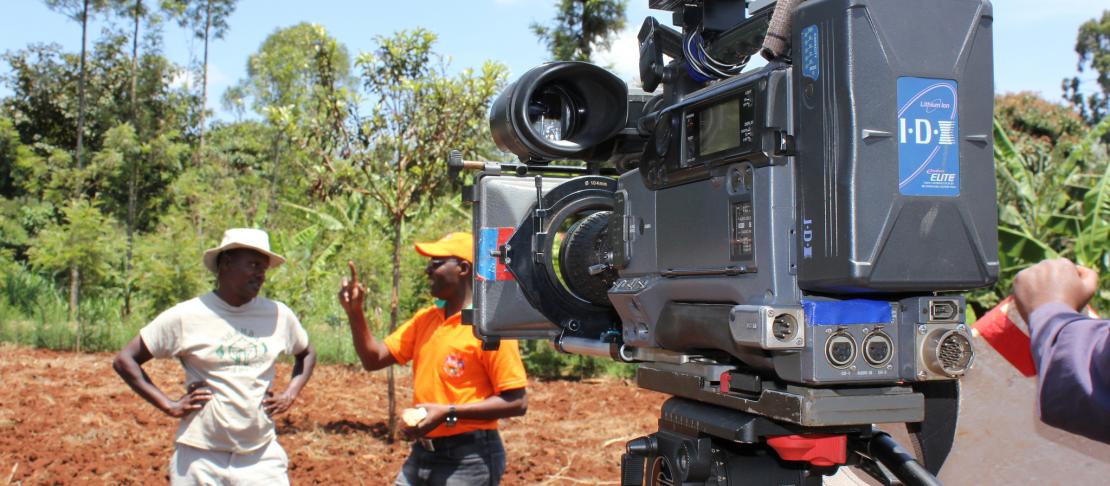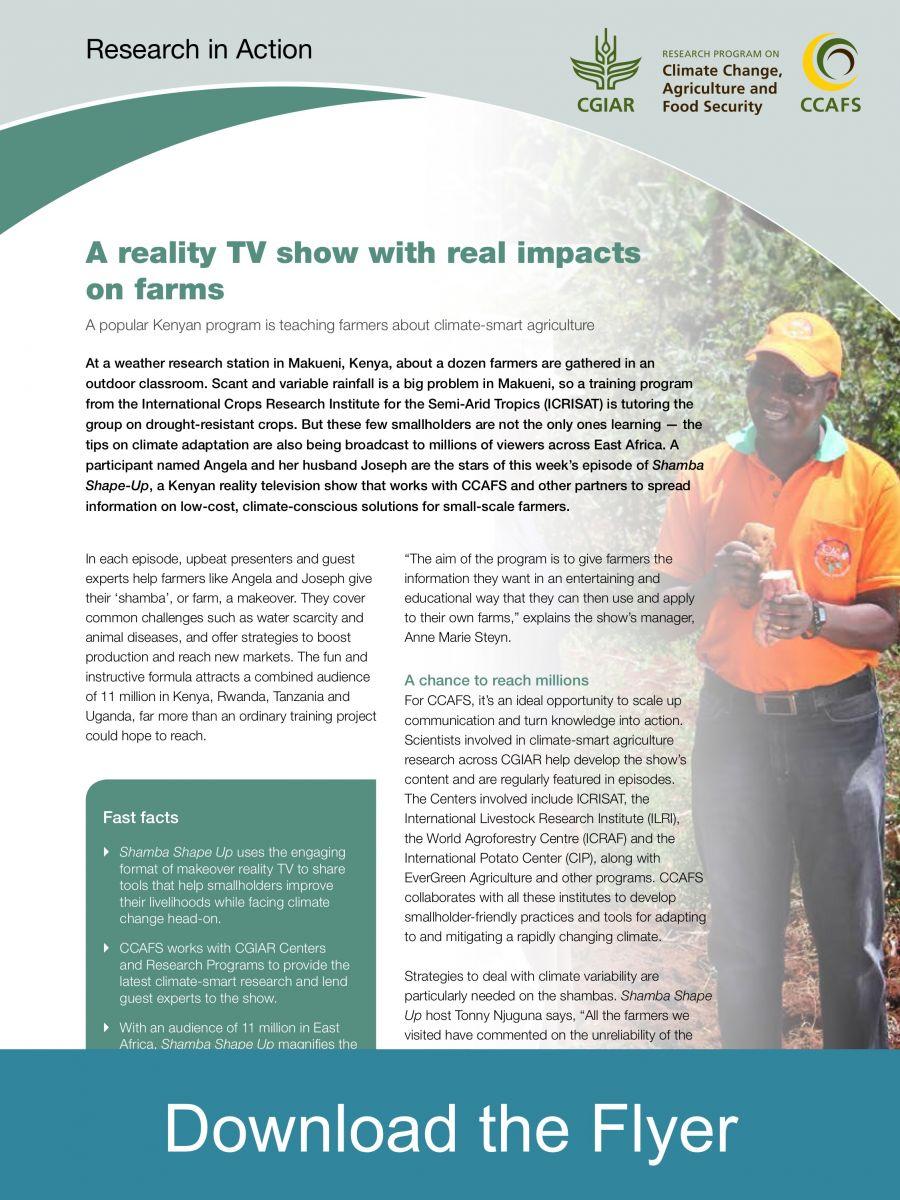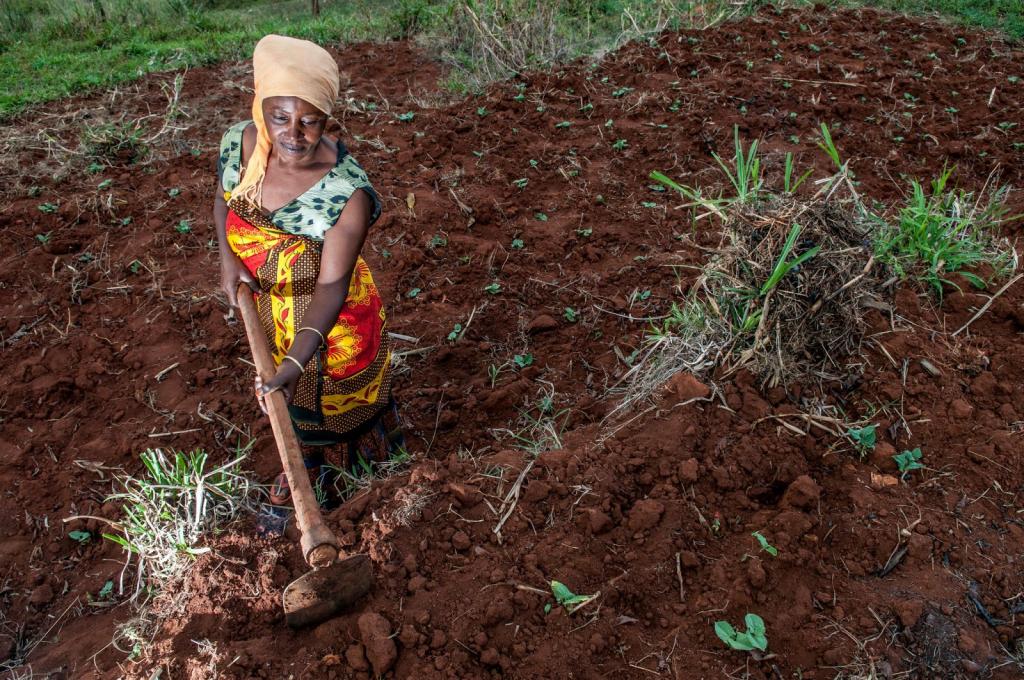Shamba Shape Up: a reality TV show with real impacts on farms

A popular Kenyan program is teaching farmers about climate-smart agriculture.
 At a weather research station in Makueni, Kenya, about a dozen farmers are gathered in an outdoor classroom. Scant and variable rainfall is a big problem in Makueni, so a training program from the International Crops Research Institute for the Semi-Arid Tropics (ICRISAT) is tutoring the group on drought-resistant crops. But these few smallholders are not the only ones learning — the tips on climate adaptation are also being broadcast to millions of viewers across East Africa.
At a weather research station in Makueni, Kenya, about a dozen farmers are gathered in an outdoor classroom. Scant and variable rainfall is a big problem in Makueni, so a training program from the International Crops Research Institute for the Semi-Arid Tropics (ICRISAT) is tutoring the group on drought-resistant crops. But these few smallholders are not the only ones learning — the tips on climate adaptation are also being broadcast to millions of viewers across East Africa.
A participant named Angela and her husband Joseph are the stars of this week’s episode of Shamba Shape-Up, a Kenyan reality television show that works with CCAFS and other partners to spread information on low-cost, climate-conscious solutions for small-scale farmers.
In each episode, upbeat presenters and guest experts help farmers like Angela and Joseph give their ‘shamba’, or farm, a makeover. They cover common challenges such as water scarcity and animal diseases, and offer strategies to boost production and reach new markets. The fun and instructive formula attracts a combined audience of 11 million in Kenya, Rwanda, Tanzania and Uganda, far more than an ordinary training project could hope to reach.
“The aim of the program is to give farmers the information they want in an entertaining and educational way that they can then use and apply to their own farms,” explains the show’s manager, Anne Marie Steyn.
A chance to reach millions
For CCAFS, it’s an ideal opportunity to scale up communication and turn knowledge into action. Scientists involved in climate-smart agriculture research across CGIAR help develop the show’s content and are regularly featured in episodes.
Communication at scale
- Shamba Shape Up grew from an estimated 7 million viewers in 2012 to 11 million by late 2014.
- 87% of smallholder viewers said they learned something and 45% said they adopted new practices. Over 90% of those who made changes claimed their households had more food or income as a result.
- In one study, maize farmers who used soil improvements shown on the program gained a net profit of about USD 82 per season. Dairy farmers used various husbandry tips to gain USD 59 per month.
- If only 10% of the total audience follows advice from the show and receives similar benefits, the subsidy to smallholders could be hundreds of millions of dollars per year.
The Centers involved include ICRISAT, the International Livestock Research Institute (ILRI), the World Agroforestry Centre (ICRAF) and the International Potato Center (CIP), along with EverGreen Agriculture and other programs.
CCAFS collaborates with all these institutes to develop smallholder-friendly practices and tools for adapting to and mitigating a rapidly changing climate.
Strategies to deal with climate variability are particularly needed on the shambas. Shamba Shape Up host Tonny Njuguna says, “All the farmers we visited have commented on the unreliability of the weather.”
For Angela and Joseph, water supply is the main obstacle. The presenters coach them to collect rain from gutters, plant sorghum varieties that thrive on a short rainy season, and add hardy trees to prevent soil erosion.
The techniques are detailed further in free pamphlets that viewers can obtain by sending an SMS message. Over its first 18 months, 70,000 people contacted the show for more information. There’s also a growing social media audience, with 40,000 ‘likes’ on Shamba Shape Up’s Facebook page and almost 3,000 engaged Twitter followers.
Measuring the impacts
The program clearly has people’s attention, but what are the actual impacts? In a 2014 survey by Mediae, the company that produces Shamba Shape Up, 87% of smallholders who watched the series said they had learned something new, and 45% had adopted at least some of the practices demonstrated — most commonly methods for improving soil fertility.
The Africa Enterprise Challenge Fund (AECF), which funded the show’s pilot series, has also sponsored economic impact surveys of the target audience. An AECF study in 2014 (PDF) estimated that in Kenya’s agrarian region more than 400,000 households benefitted from Shamba Shape Up, and the increased income for dairy farmers alone totalled about USD 24 million.
The AECF study called the show “a trusted source of information presented in a format that engages farmers’ interest and emotions, encourages discussion and provides opportunity for follow-up and interaction.” In fact, the study found that Shamba Shape Up is more trusted than other, more conventional sources of information.
Results like this prove the saying that a picture is worth a thousand words, especially when that picture is beamed out to millions of TVs. Shamba Shape Up’s edutainment programming is powerful encouragement for farmers to try new techniques and improve their livelihoods.

Shamba Shape Up disseminates climate-smart agriculture information and how-to knowledge to millions of smallholders in East Africa. Photo: G. Smith (CIAT)
Case study: “I’ve learned many, many things”
Ann Kavuu is a small-scale farmer and Shamba Shape Up fan in Machakos county, Kenya. She talked to CCAFS staff in 2014 about what she’s taken away from the series:
I’ve learned a lot of things from Shamba Shape Up. Agroforestry, water harvesting, soil conservation—many, many things. I plan to plant more trees, especially trees that can be sold for timber. I’ve started growing one particular species known as Melia. I’ve tried to grow quite a number of them, around 200-plus. I’ve grown a lot of Grevaria trees because I’ve learned of their importance in nitrogen fixing. I happen to be from a place that is very dry, and dry areas have limitations of such nutrients.
My trees are helping my shamba to be different from the others around. Many seasons some people would harvest nothing, but there’s no season when I’ve gone without harvesting. So I believe it is because of these trees that I have grown.